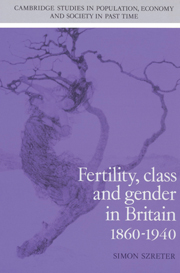Book contents
- Frontmatter
- Contents
- List of figures
- List of tables
- Acknowledgements
- List of abbreviations
- Introduction
- Part I Historiographical introduction: a genealogy of approaches
- Part II The professional model of social classes: an intellectual history
- Part III A new analysis of the 1911 census occupational fertility data
- Part IV Conceptions and refutations
- 9 A general approach to fertility change and the history of falling fertilities in England and Wales
- 10 Social class, communities, gender and nationalism in the study of fertility change
- Appendices
- Bibliography
- Index
- Cambridge Studies in Population, Economy and Society in the Past Time
9 - A general approach to fertility change and the history of falling fertilities in England and Wales
Published online by Cambridge University Press: 16 February 2010
- Frontmatter
- Contents
- List of figures
- List of tables
- Acknowledgements
- List of abbreviations
- Introduction
- Part I Historiographical introduction: a genealogy of approaches
- Part II The professional model of social classes: an intellectual history
- Part III A new analysis of the 1911 census occupational fertility data
- Part IV Conceptions and refutations
- 9 A general approach to fertility change and the history of falling fertilities in England and Wales
- 10 Social class, communities, gender and nationalism in the study of fertility change
- Appendices
- Bibliography
- Index
- Cambridge Studies in Population, Economy and Society in the Past Time
Summary
Parts I and II of this study have provided an extended critique of the orthodox representation of falling fertility in Britain before 1911. In the course of the exploratory statistical analysis in Part III a number of specific new findings have emerged. It is now time to draw all these together and to attempt to produce a coherent, general alternative to the old orthodoxies. First, a new general framework for approaching the study of fertility change will be suggested. Secondly, this will be used as the basis for a new interpretation of the history of falling fertilities in modern Britain which is consistent both with the 1911 evidence of occupational variation and with the wider context of modern Britain's social history and its current historiography.
The perceived relative costs of childrearing: a general heuristic framework for studying fertility change
At the outset of his celebrated article published in 1966 Gösta Carlsson elegantly expressed the enigma which lies at the heart of explaining the phenomenon of fertility change: ‘It is an instance of highly significant social change through individual or at least decentralised decision’. There is apparently something very general involved in the episodes of secular falls in fertility which have occurred in so many societies in different parts of the globe and at different points in their respective trajectories of economic development.
- Type
- Chapter
- Information
- Fertility, Class and Gender in Britain, 1860–1940 , pp. 443 - 532Publisher: Cambridge University PressPrint publication year: 1996
- 1
- Cited by



